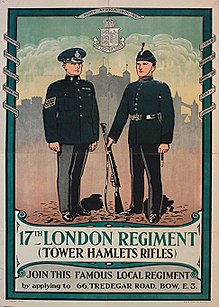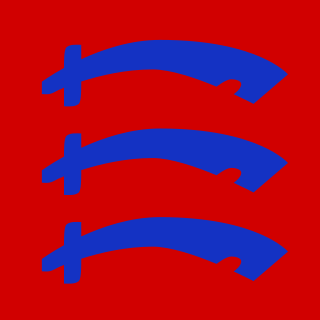| Unit | RVC identity | Volunteer Battalion identity | Headquarters | 1938 identity |
|---|
| 1st London Division |
|---|
| 1st London Brigade |
|---|
| 1st (City of London) Battalion, London Regiment (Royal Fusiliers) | 10th Middlesex RVC | 1st Volunteer Battalion, Royal Fusiliers | Bloomsbury (Handel Street) | 8th (1st City of London) Battalion, Royal Fusiliers |
| 2nd (City of London) Battalion, London Regiment (Royal Fusiliers) | 23rd Middlesex RVC | 2nd Volunteer Battalion, Royal Fusiliers | Westminster (Tufton Street) | 9th (2nd City of London) Battalion, Royal Fusiliers |
| 3rd (City of London) Battalion, London Regiment (Royal Fusiliers) | 11th Middlesex RVC | 3rd Volunteer Battalion, Royal Fusiliers | St Pancras (Edward Street) [lower-alpha 1] | 10th (3rd City of London) Battalion, Royal Fusiliers |
| 4th (City of London) Battalion, London Regiment (Royal Fusiliers) | 1st Tower Hamlets RVC | 4th Volunteer Battalion, Royal Fusiliers | Shoreditch (Shaftesbury Street) [lower-alpha 2] | 60th (City of London) Anti-Aircraft Regiment, Royal Artillery |
| 2nd London Brigade |
|---|
| 5th (City of London) Battalion, London Regiment (London Rifle Brigade) | 1st London VRC (City of London Volunteer Rifle Brigade) | 9th Volunteer Battalion, King's Royal Rifle Corps | Finsbury (Bunhill Row) [lower-alpha 2] | 1st Battalion, London Rifle Brigade, The Rifle Brigade (Prince Consort's Own) |
| 6th (City of London) Battalion, London Regiment (City of London Rifles) | 2nd London VRC | 10th Volunteer Battalion, King's Royal Rifle Corps | Finsbury (Farringdon Road) | 31st (City of London Rifles) Anti-Aircraft Battalion, Royal Engineers [later 31st (City of London Rifles) Searchlight Regiment, Royal Artillery] |
| 7th (City of London) Battalion, London Regiment | 3rd London VRC | 11th Volunteer Battalion, King's Royal Rifle Corps | Finsbury (Sun Street) [lower-alpha 2] | 32nd (7th City of London) Anti-Aircraft Battalion, Royal Engineers [later 32nd (7th City of London) Searchlight Regiment Royal Artillery] |
| 8th (City of London) Battalion, London Regiment (Post Office Rifles) | 24th Middlesex VRC | 7th Volunteer Battalion, Rifle Brigade | Finsbury (Bunhill Row) [lower-alpha 2] | n/a [lower-alpha 3] |
| 3rd London Brigade |
|---|
| 9th (County of London) Battalion, London Regiment (Queen Victoria's), Berkeley Square | 1st Middlesex (Victoria and St. George's) VRC | 4th Volunteer Battalion, King's Royal Rifle Corps | Westminster (Davies Street) | Queen Victoria's Rifles, King's Royal Rifle Corps |
| 19th Middlesex (St. Giles's and St. George's, Bloomsbury) VRC | 6th Volunteer Battalion, Rifle Brigade |
| 10th (County of London) Battalion, London Regiment (Paddington Rifles); disbanded 1912 | 18th Middlesex VRC | 4th Volunteer Battalion, Rifle Brigade | Paddington (Harrow Road) [lower-alpha 2] | n/a |
| 10th (County of London) Battalion (Hackney), London Regiment | n/a | formed in 1912 to replace the Paddington Rifles | Hackney (The Grove) [lower-alpha 2] | 5th (Hackney) Battalion, Royal Berkshire Regiment |
| 11th (County of London) Battalion, London Regiment (Finsbury Rifles) | 21st Middlesex (Finsbury) VRC | 7th Volunteer Battalion, King's Royal Rifle Corps | Pentonville (Penton Street) [lower-alpha 2] | 61st (Middlesex) Anti-Aircraft Brigade, Royal Artillery |
| 12th (County of London) Battalion, London Regiment (The Rangers) | 22nd Middlesex VRC (Central London Rangers) | 8th Volunteer Battalion, King's Royal Rifle Corps | Holborn (Chenies Street) | The Rangers, King's Royal Rifle Corps |
| 2nd London Division |
|---|
| 4th London Brigade |
|---|
| 13th (County of London) Battalion, London Regiment (Kensington) | 4th (Kensington) Middlesex VRC | 3rd Volunteer Battalion, King's Royal Rifle Corps | Kensington (Iverna Gardens) | Princess Louise's Kensington Regiment, Middlesex Regiment (Duke of Cambridge's Own) |
| 14th (County of London) Battalion, London Regiment (London Scottish) | 7th (London Scottish) Middlesex VRC | 1st Volunteer Battalion, Rifle Brigade | Westminster (Buckingham Gate) [lower-alpha 2] | London Scottish, Gordon Highlanders |
| 15th (County of London) Battalion, London Regiment (Prince of Wales' Own Civil Service Rifles) | The Prince of Wales's Own 12th Middlesex (Civil Service) VRC | 5th Volunteer Battalion, King's Royal Rifle Corps | Westminster (Somerset House) | n/a [lower-alpha 4] |
| 16th (County of London) Battalion, London Regiment (Queen's Westminster Rifles) | 13th Middlesex (Queen's Westminster) VRC | 6th Volunteer Battalion, King's Royal Rifle Corps | Kensington (Buckingham Gate) | Queen's Westminsters, The King's Royal Rifle Corps [Later 11th & 12th (Queen's Westminsters) Battalions, King's Royal Rifle Corps] |
| 5th London Brigade |
|---|
| 17th (County of London) Battalion, London Regiment (Poplar and Stepney Rifles) | 2nd Tower Hamlets VRC | 9th Volunteer Battalion, Rifle Brigade | Bow (Tredegar Road) [lower-alpha 2] | Tower Hamlets Rifles, Rifle Brigade (Prince Consort's Own) [later 9th Battalion, The Rifle Brigade (Prince Consort's Own) (Tower Hamlets Rifles); 656th Light Anti-Aircraft Regiment Royal Artillery (Rifle Brigade)] |
| 18th (County of London) Battalion, London Regiment (London Irish Rifles) | 16th Middlesex (London Irish) VRC | 3rd Volunteer Battalion, Rifle Brigade | Chelsea (Duke of York's Headquarters) | London Irish Rifles, Royal Ulster Rifles |
| 19th (County of London) Battalion, London Regiment (St. Pancras) | 17th Middlesex (North Middlesex) VRC | 3rd Volunteer Battalion, Middlesex Regiment | Camden Town (High Street) [lower-alpha 2] | 33rd (St. Pancras) Anti-Aircraft Battalion, Royal Engineers [later 33rd (St. Pancras) Anti-Aircraft Battalion, Royal Artillery] |
| 20th (County of London) Battalion, London Regiment (Blackheath and Woolwich) | 3rd Kent VRC | 2nd Volunteer Battalion, Queen's Own (Royal West Kent Regiment) | Blackheath (Holly Hedge House) | 34th (The Queen's Own Royal West Kent) Anti-Aircraft Battalion, Royal Engineers [later 34th Searchlight Regiment, Royal Artillery (Queen's Own Royal West Kent)] |
| 6th London Brigade |
|---|
| 21st (County of London) Battalion, London Regiment (First Surrey Rifles) | 1st Surrey (South London) VRC | 1st Volunteer Battalion, East Surrey Regiment | Camberwell (Flodden Road) [lower-alpha 5] | 35th (First Surrey Rifles) Anti-Aircraft Battalion, Royal Engineers [later 35th Searchlight Regiment, Royal Artillery (First Surrey Rifles)] |
| 22nd (County of London) Battalion, London Regiment (Queen's) | 6th Surrey RVC | 3rd Volunteer Battalion, Queen's (Royal West Surrey Regiment) | Bermondsey (Jamaica Road) [lower-alpha 2] | 6th (Bermondsey) Battalion, The Queen's Royal Regiment (West Surrey) |
| 23rd (County of London) Battalion, London Regiment | 7th Surrey RVC | 4th Volunteer Battalion, East Surrey Regiment | Battersea (St John's Hill) | 42nd (7th (23rd London) Bn, The East Surrey Regiment) Battalion, Royal Tank Regiment |
| 24th (County of London) Battalion, London Regiment (Queen's) | 8th Surrey RVC | 4th Volunteer Battalion, Queen's (Royal West Surrey Regiment) | Southwark (New Street) | 7th (Southwark) Battalion, The Queen's Royal Regiment (West Surrey) |
| Others |
|---|
| 25th (County of London) Cyclist Battalion, London Regiment. | 26th (Cyclist) Middlesex VRC | Rifle Brigade | Fulham (Fulham House) | n/a [lower-alpha 6] |
| 26th (County of London) Battalion | | Title allotted to Infantry Battalion, Honourable Artillery Company but never used | | |
| 27th (County of London) Battalion | | Title allotted to the Inns of Court Regiment but never used | | |
| 28th (County of London) Battalion, London Regiment (Artists Rifles) | 20th Middlesex (Artists) VRC | 6th Volunteer Battalion, Rifle Brigade | St Pancras (Dukes Road) | Artists Rifles, Rifle Brigade (Prince Consort's Own) [later 163 Officer Cadet Training Unit] |
| 29th (City of London) Battalion [lower-alpha 7] | | | | |
| 30th (City of London) Battalion [lower-alpha 8] [lower-alpha 9] | | | | |
| 31st (County of London) Battalion [lower-alpha 10] [lower-alpha 9] | | | | |
| 32nd (County of London) Battalion [lower-alpha 11] [lower-alpha 9] | | | | |
| 33rd (City of London) Battalion London Regiment (Rifle Brigade) [lower-alpha 12] [lower-alpha 13] | | | | |
| 34th (County of London) Battalion, London Regiment (King's Royal Rifle Corps) [lower-alpha 12] [lower-alpha 14] | | | | |









